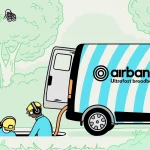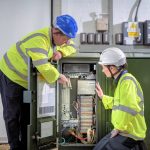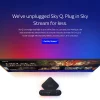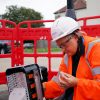Do You Have Full Fibre Broadband? A Third of UK Consumers Don’t Know

A recent YouGov survey of 2,033 UK adults, which was commissioned by Point Topic and conducted online during November 2022, has revealed that 35.5% of respondents were still unsure as to whether their home broadband ISP connections were based off “full fibre” (FTTP/B/H) technology or not.
In simple terms, a full fibre connection is one that sends a light signal (laser) down an optical fibre cable – made of glass or plastic – directly to your home. The benefits of this approach include significantly faster and more stable speeds (possibly into Terabits further down the road – at the domestic level), greater reliability, faster latency times, energy efficiency, lower maintenance costs and so forth.
However, numerous broadband ISPs also spent the best part of the previous decade selling slower “part-fibre” or “hybrid-fibre” (e.g. FTTC / VDSL2, G.fast, Hybrid Fibre Coax) solutions as “fibre broadband” products, which is one of the reasons why so many people continue to be confused about the terminology today (i.e. if you think you’ve got it already, then you may be less likely to contemplate an upgrade).
Advertisement
Admittedly, even Point Topic could be said to be muddying the waters here, since their own definition of “full fibre” includes Fibre-to-the-Building (FTTB) connections. The tricky thing about FTTB, which has in the past been used to hook-up apartment blocks, is that the last few metres into individual flats / apartments may be carried over either fibre or a copper line (often coax). But FTTB and FTTP/H are usually spoken of in the same breath as, in the real-world, there’s rarely much of a noticeable performance difference between them (at least for today’s 1Gbps needs).
Lest we also forget Virgin Media’s promotion of their old Hybrid Fibre Coax (HFC) based DOCSIS network as a “fibre” service, although in fairness that standard can deliver multi-gigabit download speeds. But upload performance is a different matter, at least in the UK, and at the end of the day it’s not true end-to-end fibre (VMO2 are now replacing HFC with XGS-PON FTTP).
At this point we could continue on to highlight the various perceived historic failings of the Advertising Standards Authority (ASA), and others, in failing to tackle such confusion earlier on (example). But most of our readers will already be familiar with that and we don’t want to rehash an old debate too much.
However, what Point Topic’s survey doesn’t tell us is whether the failure to understand “full fibre“, at least in terms of the customers’ perception of their own home connection, has actually had a major negative impact upon the take-up of faster broadband speeds via full fibre packages. At the end of the day, most consumers seem to pick a package based more on a combination of price, speed and quality than specific technology.
Advertisement
Nevertheless, it’s worth remebering that in 2021 the Gigabit Take-Up Advisory Group (GigaTAG) proposed several changes (here) to the Government and Ofcom, which were aimed at helping to boost the take-up of gigabit-capable broadband services. One of those included clearer labelling of broadband packages to help consumers understand the differences. But after nearly two years, there still hasn’t been much movement on that.
Mark is a professional technology writer, IT consultant and computer engineer from Dorset (England), he also founded ISPreview in 1999 and enjoys analysing the latest telecoms and broadband developments. Find me on X (Twitter), Mastodon, Facebook, BlueSky, Threads.net and Linkedin.
« Lyca Mobile UK Announce 6 Month Price FREEZE on 4G and 5G Plans























































All the mess created by Ofcom & ASA allowing the big boys to falsely advertise fibre for FTTC.
Actually they originally allowed it for Virgin Media cable, not FTTC, but as the story says this has been done a ton of times.
Yeah, that was a huge failure and I gave up trying to explain what VDSL is to people.
ASA really failed to regulate broadband ISP advertising.
Agree with Reality Bytes (now I’m worried).
To be fair to VM though a little bit, HFC is a lot closer to being fibre than FTTC/twisted pair. Coax has a hell lot more bandwidth than copper phone cable and better noise insulation. It was only a short run to the cabinet too compared to telephone wires as not all of those went to a local cabinet nearby depending on area.
Coax is no closer to being fibre than twisted pair regardless of how much bandwidth it can carry.
All those point to point twisted pairs carry more now via G.Fast than Virgin offered at the time the ASA allowed Virgin to call their HFC fibre.
They are both made of copper. Neither is more fibre than the other and neither should ever have been allowed to be advertised as fibre.
Yep, with big posters on the cabinets saying Fibre broadband is here.
Given how spineless the ASA were on this, it shows the ISPs missed a trick—
ISPs should have advertised ADSL as “fibre to the exchange”
@ad47uk – technically “Fibre is here” is right on those fibre cabs. Just a shame that’s also where fibre ends.
I don’t blame them for not knowing they describe FTTC VDSL2 Broadband as Fibre Broadband totally confusing. They should call it VDSL Broadband ADSL Broadband and Full Fibre Broadband.
If a naming structure were to be imposed, it would need to be consistent rather than being a mixture of protocol for some and media for others. For example, “copper broadband” (eg for ADSL), “hybrid fibre broadband” (for VDSL, G-Fast, cable) and “full fibre broadband”.
I wouldn’t have Fibre in the name at all. Copper Broadband. Superfast Copper Broadband and Fibre Broadband is what I would use. And what the ISPs should have used.
Copper Broadband
Hybrid Broadband
Fibre Broadband
Would have sufficed.
@Anthony, @Bill
What is the issue with hybrid fibre broadband for FTTC etc?
I know some people on here have a problem with shortening FTTC to fibre broadband but, like it or not, the industry calls it fibre to the cabinet (or node / curb etc). Adding the word hybrid to distinguish it from FTTP seems a reasonable compromise.
Many agreed one of the main reasons HD-DVD format failed was because it still had DVD in its name. One of the main reasons the WIIU failed was because it had Wii in the name. Its too confusing to consumers to have similar names for different products.
@anthony Doesn’t seem to affect the Playstation.
Neither does that appear to affect iphones.
I’m not sure of the value of this survey, as it’s suggesting that 65% of respondents know about the physical infrastructure used to deliver their internet connection, and that seems really high to me.
Similarly, we have about 38% of England saying their main broadband service is FTTP – that doesn’t make sense when FTTP availability is at 47% across England and takeup figures are nowhere near 50% yet.
By example, according to TBB the North East has 37% FTTP coverage (https://labs.thinkbroadband.com/local/north-east) but 42% of people from the North East responding to the survey believe they subscribe to it.
The ISPs have been door to door obsessively in the North East trying to get people to sign up for FTTP so I suspect a good number now know what it is from this alone. Not one single week goes by one of the ISPs is not banging on your front door trying to get you to sign up for FTTP.
Simple solution, come up with a new industry wide brand name for FTTP/FTTH over the current Full Fibre…..Ultralight broadband. Red-wave Optic broadband.
Does it matter? If they don’t know, they probably don’t care and their Internet is fine.
As for the headline I’d change it to a third of a survey. Taking a sample is fine but from 2033 to 60+ million is a stretch.
I bet most people didn’t know DVDs were better than VHS before VHS’s were stopped being produced forcing everyone to switch to DVD. Should we have just kept supplying VHS tapes given people don’t know there is something much better out there?
@Anthony, but you can see the difference between DVD and VHS, well depending on your TV, a lot of people still had CRT and sometimes it was difficult to notice the difference. If someone has got a pretty good quality FTTC connection, they may not notice a difference with FTTP. If browsing, sending emails and even basic streaming they are not going to notice any difference. When you download large files or maybe have a 3 or 4 people streaming 4K at the same time, they will notice.
I notice yesterday when updating my new Mac, took ages, but then I will only do that once in a blue moon
How many people with ‘full fibre’ knew it was ‘full fibre’?
Is there a half full or half empty fibre?
Meaningless question here. Rubbish.
The plain truth is that the ASA didn’t do its job, as simple as that.
Hear, Hear GNewton.
Agree.
Time for something like this but also covering the technology used?
https://www.fcc.gov/broadbandlabels
We recently got real full fibre here and the amount of people I talk to who I know do not have full fibre go yea I have super fast full fibre too or yea I already have that etc is sad but it’s the same when people call their internet Wi-Fi etc most people in the UK don’t have even a basic understanding of how it works it may as well be magic to them
Yes real full fibre as in 940/940 is epic 🙂
Yup £30 for 900/900 3ms ping is so good
I do.
There was about a 2 month delay from it going live and the offers coming through the letterbox though, I knew it earlier since I had been waiting.
Never got my promised alert from BT though, they seem to have still not noticed.
This reminds me a bit of FULL HD vs HD Ready – basically 720p sets vs full 1080i/1080p sets. The public got confused because HD was bandied around – and many of the earlier flat screens could not do 1080i as panels supported 720p max.
Literally just had a punter saying she didn’t have a landline as she is on Fibre. And she is on FTTC – People literally have been mislead a goodun
The word “landline” is somewhat a confusing term.
Just because there is no phone service doesn’t mean that the landline is gone, it’s still used for the VDSL, or fibre service (the latter in case it’s a full fibre).
The only exception would be when using a mobile service only, because that one wouldn’t require any physical lines to the premise.
For other ISPs a customer could’ve been on SoGEA in which case no landline. Many don’t force people to take landlines they don’t want and haven’t since Openreach started selling the SoGEA products.
TL;DR a customer can be on FTTC and not have a landline.
Landline isn’t a confusing term. It means a Plain Old Telephone Service, POTS, delivered over copper wiring through the old school analogue technology.
People sometimes call a digital voice service their landline but for sure having no landline can be a thing even over a full copper service – https://www.openreach.co.uk/cpportal/products/copper/sotap
Indeed – example. Sky uses SoGEA so they can do VoIP – The ISP I work for does not – line only but calls can be added – Most people I talk to don’t use the landline anymore – I’ve only had 1 customer who relied on it for medical but BTO turned her area into FTTP only – she was not told when she ordered and so lost her landline. I sign people up to BT now if they want VoIP
Not sure everyone who comments on this website knows either.
Most are probably in new builds which come with it installed.
In my experience plenty of people just assume that “WiFi” is their internet connection and that the speed they get is entirely defined by WiFi signal strength, not the connection itself.
Given they tend to refer to FTTC and FTTP as fiber it is little wonder the average person does not know the difference.
Yep, the amount of people who say to me that their Wi-fi is down, when they mean their broadband is down.
This is a fantastic example of how we in the telecommunications industry get obsessed about technology and forget about consumers.
In truth it’s perfectly reasonable for consumers not to know which delivery medium is used for their connection. Why should they care about this? If their broadband works and the price is reasonable, then that’s (mostly) all that matters.
Consumers don’t care if the technology will last for 3 or 5 years, or if it could be upgraded to 900 Mbps if it works today.
This isn’t Ofcom or ASA’s fault, it’s the industry’s self-obsession.
The problem is we’re too quick to sell an acronym. We need to stop doing this and use clear language.
They also assume that if the service degrades to the point it is useless for what they need, that another provider will instantly enable them to switch (at almost no cost).
This could be sorted in no time by the relevant regulators making operators produce a broadband facts pack – a single line telling a customer the technology being used and offering them a link to click to find out more would suffice.
Unfortunately many years ago a cable company used ‘fibre optic’ as a selling point and that’s snowballed as in response the telco used ‘superfast fibre’ as a selling point.
The industry shouldn’t be in this position but it is where it is. I cannot think of a solution given customers have been having ‘fibre’ in the marketing to them somewhere since the noughties.
The ASA could do with showing some humility. Times and technology change, they should change with it. The broadband facts could even simply have a yes or no for full fibre.
You are of course spot on, though. Whether it’s delivered by fibre or carrier pigeon if it’s the right product at the right price the delivery medium shouldn’t matter to the average punter: thanks Virgin Media sales!
It’s perfectly simple. If you have both an Optical Network Terminator plugged into a power socket in addition to your ISP’s router, then you have full fibre, otherwise you have something else.
Not necessarily. Jurassic Fibre’s routers have a built in fibre modem, so an ONT isn’t required.
Will – thank you, I did not know that. This has been the main downside that has dissuaded me so far from switching to full fibre from VMO2. I was given to understand that the router would have to be sited next to the ONT close to where the fibre enters the house, with each powered by its own socket (rather excessive IMO for devices that must consume less than 100 watts between them), so I would have to install more 13-amp sockets. If an ONT-router combo are offered that might make it worth reconsidering.
Virgin don’t currently have an internal ONT either.
Their full fibre is currently RFOG and they fit an external ONU in the box on the wall outside with just the Virgin hub used in the home.
Though Virgin are now trialling moving this ONU to indoors and are using this in conservation areas where external boxes aren’t allowed.
Just to add to Will’s point, older Hyperoptic installations don’t use an ONT either, they have ethernet ports installed in each flat. Plenty of older DSL installations would have used a separate modem and router too so the presence of two boxes doesn’t mean much to the end-user who might not know what they do.
Ultimately it might not matter much for a consumer because they tend to buy based on cost or headline downstream bandwidth.
Yes, FTTP is “better” in some ways (though the loss of power issue is a big one rescued only by widespread mobile coverage – as long as they don’t go down too). But most of those factors don’t matter for most people, and when they do need more bandwidth or support is withdrawn they will be switched anyway.
Virgin Media have now moved completely away from fitting the ONU external to fitting it internally. An ETB is still required on the property wall to house the fibre cable from the cabinet.
Virgin media installer here.
Internal ONU’s are still in trial but full launch coming soon.
I did 6 RFOG installs today and every single 1 had an external ONU.
Is it really important if the consumers know exactly what type of connection they have, what technology is used. Many consumers refer to their internet connection as WiFi.
I would say it’s far more important for consumers to understand what connection speed they’re paying for, if they really need that speed and how to check they’re achieving the speed they’re paying for.
Believe me, if I had full fibre, I would know about it.
Openreach should never have been allowed to stick “fibre is here” on their FTTC cabinets.
Then again, Thatcher and her government should have never been allowed to kneecap BT when they wanted to develop a full fibre network in the 80s. The UK: we invent stuff, the rest of the world gets it right.
‘Openreach should never have been allowed to stick “fibre is here” on their FTTC cabinets.’
I mean it was accurate: there was fibre to the cabinets.
I do have accesa to full FTTP in my area as it’s a new built, however I can’t affors to pay £55/month. I am a gamer and I love speedy broadband, but I have to stick to a 150Mbps at £29.99 a month
Exactly this. I have FTTP as I live in a new build from 2017. However, I can’t justify the cost for the additional speed, so I pay Vodafone £24 a month for 100/20 (which is more like 114/18). Still waiting on Vodafone to add more capacity to my exchange so I can maybe look at 200/30 service. *edit* Typical, I now look at everything including gigabit is available. Interesting price points and seems my existing service has gone up in price. Makes me wonder who would pick 200 when you can get 500 for the same price
100/20 – £28 p/m
200/30 – £30 p/m
500/70 – £30 p/m
910/105 – 45 p/m
That’s just openreach overcharging I pay £30 for 1gbit symmetric with Vodafone
The other aspect re domestic broadband is that, except for Virgin (and a few other very specific instances) the actual carrier is Openreach – a spin off from BT – who own the physical network.
So far as terminology is concerned ADSL was a [copper] conventional phone line all the way back to the exchange (up to a distance of approx 3miles) When first launched around turn of century it provided up to 512K/bit download 128K/bit upload speed (or often less if you was more then a mile from the exchange) As line modulation technology improved speeds went up, download speeds of around 20M/bit
Around 2010 the old original (BT) exchange buildings started to be decommissioned, Fiber optic cables linking far smaller street cabinets direct to an area exchange. There was no direct publicity about this at the time but it did enable rather more people to get more realistic speeds.
Shortly after Fiber to the cabinet (FTTC) was officially advertised, with these cabinets, at least in major urban areas, appearing on every street corner speeds of up to around 60M/bit could be enjoyed by most customers, the service being called VDSL although those in rural areas had to put up with ADSL speeds until comparatively recently.
FTTP came into being around 2016 but confined to new build properties until around 2019 when “final mile” copper lines started to get replaced.
In my local area, we have had Openreach carrying out works to install FTTP about 2 years ago, in turn this caused several complaints – including as far as i know to the parish council as these works were not needed as we already have fibre broadband in the area
Extremely educational post! This post gives really quality data. I’m now done with it and observe that this post is truly amazing. Much obliged to you for this brief explanation and very nice information.
Spray Foam Insulation